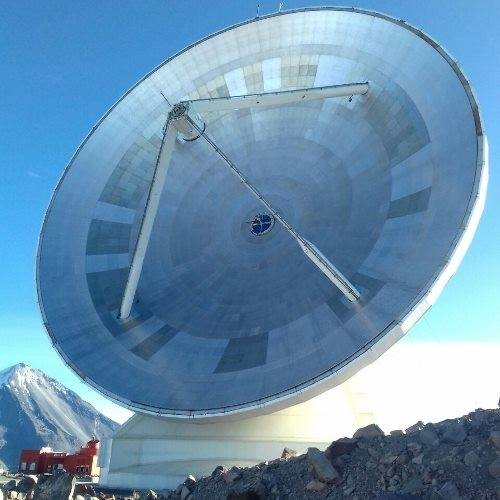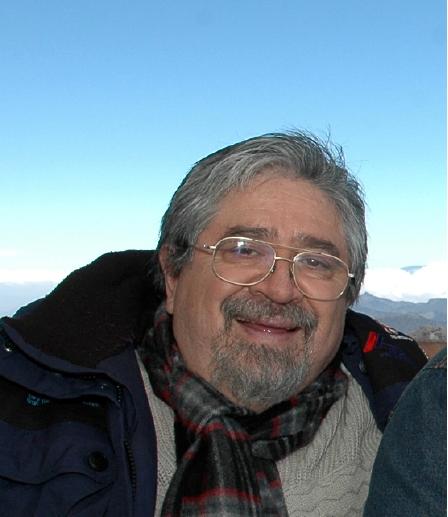A brief history of the Alfonso Serrano Large Millimeter Telescope
The Alfonso Serrano Large Millimeter Telescope (or Large Millimeter Telescope) is the world's largest single-dish, a movable telescope designed to make astronomical observations at wavelengths of 0.85 - 4mm.

On November 17, 1994, the agreement between the National Institute of Astrophysics, Optics and Electronics (INAOE) and the University of Massachusetts, Amherst (UMASS) was signed at the offices of the National Council of Science and Technology (CONACYT), which initiated the Large Millimeter Telescope project that today bears the name of its promoter. Alfonso Serrano is well remembered as the extraordinary promoter of this collaboration between Mexico and the United States.
Identified since its inception as the most ambitious scientific project in Mexico, both for its unprecedented budgetary scope and the impact of its development and scientific potential, the Alfonso Serrano Large Millimeter Telescope (LMT) has been a clear icon of Mexican science. Today, the LMT is an internationally competitive astronomical instrument in operation at the service of the national scientific community. It has been a long road that awaits a final milestone: the consolidation of the LMT as the instrument proposed in November 1994.
The idea of building a large millimeter telescope was proposed by Alfonso Serrano in 1988 when he was director of the Institute of Astronomy at UNAM. The proposal, together with UMASS, to build for the first time in the world a 50-meter diameter antenna capable of making astronomical observations at wavelengths between 0.8 and 4.0 millimeters was controversial from the beginning.
Two considerations are enough to understand what the proposal meant: despite its dimensions, the antenna should be able to be positioned with an accuracy of one arc second; moreover, its 2000 m2 surface should not deviate more than 75 microns about a perfect parabola. The project had to wait for Serrano's arrival as Director-General of INAOE in 1992 before it could be lobbied until its joint approval in Mexico and the United States two years later.
One of the first tasks of the project was to choose a location with an atmosphere with low water vapor content suitable for observations in the millimeter band. The search for the LMT site culminated in February 1997 with the selection of the Sierra Negra volcano, the highest mountain of more than thirty summits considered. At 4582 meters, the Sierra Negra or Tliltepetl volcano is the fourth highest peak in the country.
The altitude of the site has resulted in an optimal atmosphere in the millimeter band, representing at the same time a great challenge for the development of the telescope and its infrastructure in an environment where the amount of oxygen in the air is 55% of that at sea level. Shortly after the site was chosen, it was necessary to widen the access road to a width of six meters to allow the transport of the parts that would make up the antenna structure.

In 1998 the German company MAN Technologie won the international competition for the design of the LMT. The titanic process of building the telescope began in 1999, with the foundations manufactured by the COSMOS group with the support of CEMEX, and culminated at the end of 2006, when the antenna structure was completed, with 85% participation of Mexican companies and inaugurated by President Vicente Fox. At the inauguration ceremony, the LMT made an astronomical observation in the 2-centimeter band using the 84 panels installed, out of the 180 that should make up the telescope.
Difficult times followed for the project between 2007 and 2009, due to the harsh audit of the 2006 public account and the unjust discrediting of the project. In 2010 the first light plan was approved, leading to the first observations in the millimeter band jointly announced by INAOE and UMASS in June 2011, a few weeks before the death of Alfonso Serrano, whose last great satisfaction was the functional demonstration of the LMT, the first step towards its consolidation as a scientific instrument.
Years have passed since that first light and the death of Alfonso Serrano. His legacy not only remains in force but has been strengthened over time, progressively overcoming the bad omens with tangible results. During the project, knowledge was generated on topics such as carbon fiber manufacturing and advanced astronomical detectors that are currently being developed in INAOE laboratories by scientists trained within the same project.
This at the same time that the telescope has begun to be used by the communities of Mexico and Massachusetts: on March 21, 2013, the first call for its scientific use was announced, which began a month and a half later. At that time the LMT entered an operational phase of systematic night-by-night work, with numerous seasons of astronomical observations already completed. Astronomers from both countries have been developing dozens of projects with the LMT's first-light receivers: the Redshift Search Receiver spectrograph and the AzTEC bolometer camera.
Perhaps most significant has been the very long-baseline interferometry project, in which researchers abroad have shown great interest in connecting the LMT to antennas around the world in a global effort to observe in exquisite detail the black hole at the center of the Milky Way. This is a clear acceptance by the international scientific community that identifies the LMT, the largest antenna in the intercontinental array, as a highly competitive instrument.
The reality of the Alfonso Serrano Large Millimeter Telescope as a highly competitive astronomical instrument at the service of the national scientific community is a fact. The formal establishment of the LMT National Observatory culminates the odyssey of the LMT with the enlargement of the telescope's primary surface from its diameter of 32 meters to the 50 meters specified in 1994, and for which the antenna was built. This competitive telescope is an instrument without a peer in the world. This is the last stretch of the long road started in 1994 by Alfonso Serrano, a visionary scientist who forged a Mexico of great achievements.
By Alberto Carramiñana Alonso
Dr. Alberto Carramiñana Alonso is a graduate of the Faculty of Sciences of the UNAM, where he received his B.Sc. and M.Sc. degrees in Physics. He obtained his Ph.D. in high energy astronomy from the University of Durham, England, and later completed a postdoctoral stay at the European Space Agency in Holland. Since 1993 he has worked at the National Institute of Astrophysics, Optics, and Electronics in Tonantzintla, Puebla, where he served as Astrophysics Coordinator for more than ten years. He is the author or co-author of 50 research articles published in specialized journals and 100 papers in international congresses, in addition to several articles and a popular science book. He is a member of the National System of Researchers and the Mexican Academy of Sciences, in addition to having been a member of the Academic Technical Committee of the High Energy Physics Network of CONACyT and Mexico before the International Astronomical Union. He is part of the Collaboration Council of the Alfonso Serrano Large Millimeter Telescope and is responsible for Mexico within the HAWC collaboration, dedicated to the installation and scientific exploitation of a gamma-ray observatory at the Sierra Negra volcano. He is currently director-general of the National Institute of Astrophysics, Optics, and Electronics, INAOE.
Source: University of Michoacan




